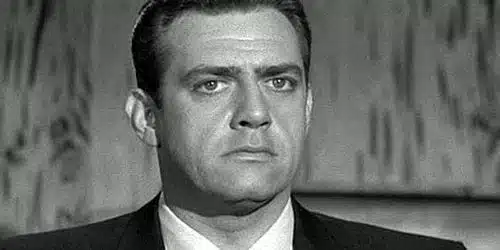
This set contains the first 15 episodes of the ninth and final season of the original run of TV’s Perry Mason, as first aired in the 1965-66 season, and faithful viewers will notice a few changes. First, the opening theme is quieter and slinkier. Second, there are two new regulars: Richard Anderson as Lt. Steve Drumm, taking over duties as the show’s investigating homicide detective who habitually arrests the wrong person, and Dan Tobin as Terrance Clay, owner of the restaurant and bar where everyone hangs out. He stands around in dapper vests and makes jokes about his Irish heritage. Third, and most disappointingly, the mysteries are mostly obvious and predictable. These are the easiest whodunits in the series, and the blame probably rests with new story consultants Orville H. Hampton (who wrote more than half the season’s episodes) and Ernie Frankel. Perhaps Hampton stepped into this prestigious job on a long-running hit because he was freshly hot from an Oscar nomination for One Potato, Two Potato, which wasn’t a whodunit.
The premiere, Hampton’s “The Case of the Laughing Lady”, has an unusual set-up in that the murder has already occurred and Perry’s client (Jean Hale) has already struck out with a court-appointed counsel when she recognizes a mysterious laugh on a TV program in jail. Like many episodes this season, this touches on social issues–in this case, the different defenses received by the poor and those who can afford a good lawyer–something the series had almost completely avoided. Speeches were left to socially conscious shows like The Defenders, but this season gives several signs of acknowledging reality. This episode, set in the art world, introduces the concept of investigative spying via electronic devices, which Perry would employ more than once this season. Finally, this episode featues a dazzling array of recurring guests, including Constance Towers, John Dall, Bernard Fox, Allison Hayes, and John Abbott.
Several episodes take odd angles. Novelist Henry Farrell (Whatever Happened to Baby Jane) provides “The Case of the Wrathful Wraith”, which opens with Perry’s client (Jeanne Bal) having the charge dismissed and moves on to what seems a Gothic case of haunting. (He also concocted the strange situation in “The Case of the Bogus Buccaneers”.) Stories that attempt to be topical include “The Case of the Silent Six”, an indirect comment on the Kitty Genovese case of 1964, and “The Case of the Fugitive Fraulein”, which unconcinvingly mixes Perry into Cold War shenanigans in East Berlin. The latter is the disappointing final script from Jonathan Latimer, one of the series’ most interesting writers.
The series’ returning regulars are Raymond Burr as Mason; Barbara Hale as his secretary Della Street; William Hopper as private detective Paul Drake; William Talman as D.A. Hamilton Burger; and Lee Miller as Sgt. Brice. Jesse Hibbs directs most episodes, with Vincent McEveety providing unusually deft movements for “The Case of the Baffling Bug”, a story emphasizing the hot mid-60s topics of surveillance and industrial espionage. These topics are still timely, of course, and it’s naively touching to see the characters fretting about the new morality of it.
Other guests include Julie Adams, Jesse White, Nancy Gates, H.M. Wynant, Louise Latham, Barry Atwater, Lee Meriwether, Stuart Erwin, Robert Emhardt, Bruce Bennett, Whit Bissell, Noah Beery Jr., Hugh Marlowe, K.T. Stevens, Strother Martin, Regis Toomey, Michael Constantine, Anthony Caruso, Gavin MacLeod, Robert H. Harris, Paul Winfield, Skip Homeier, Virginia Gregg, Jeanette Nolan, Grant Williams, Teru Shimada, Aliza Gur, Bruce Glover, Kathleen Crowley, Leonard Stone, Meg Wyllie, and Richard Jaeckel.
